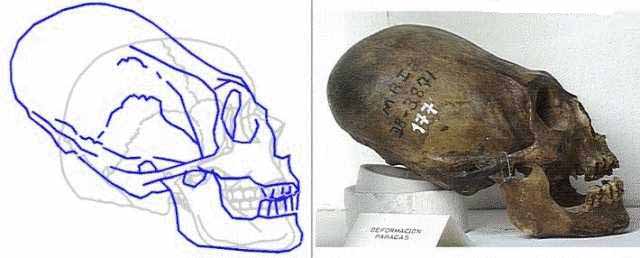
These skulls were photographed by Robert Connolly on his trip around the world during which he was collecting materials about ancient civilizations. The discovery of unusual skulls was thus an unintended "spinoff" of his efforts.
The data about the skulls is incomplete, and that makes the correct assessment of their age, context with other hominids, as well as placement of their origin extremely difficult. Some of the skulls are very distinct, as if they belong to entirely different species, remotely similar to genus Homo. The first thing that attracts attention is the size and shape of the cranium in all the specimens. There are 4 different groups represented in the pictures. As a matter of convenience, I labeled them "conehead", "jack-o-lantern" or "J" and "M" based on the shape of the skull, except the first and possibly earliest type of skull, which I call "premodern".
When some of these pictures (the first two) were posted on CompuServe more than year ago, the majority of people assumed that they represented an example of binding of the head, well known to be in fashion in ancient Nubia, Egypt and other cultures. The problem with this theory is that the inside of the cranium of the mentioned skulls, although elongated and with a back sloping, flattened forehead, have the same capacity as normal human skulls; the only difference is the shape achieved by frontal and side deformations. They are actually more similar to the first type of skull (premodern) with the rounded back, than the conehead type. The cone-shaped types of skull are not found amongst the usual skull-binding samples.
The first skull presents problems of its own. The frontal part of the skull seems to belong to an individual of the pre-Neanderthal family, but the lower jaw, though more robust than modern human type, has a modern shape and characteristics. The shape of the cranium does not have any comparison with the Erectus, Neanderthal types, nor the modern human type. Some minor Neanderthal characteristics are present, as is the occipital ridge on the bottom back of the skull and the flattened bottom of the cranium, other characteristics point more tovards Homo Erectus. The angle of the cranial bottom is, though, unusual. We cannot exclude the possibility of a deformed individual in this case, but it is highly unlikely that the angle of the frontal part would require a modification of the lower jaw in the process of growing to resemble modern human types with their projected chin rim. The answer seems to be that the skull belongs to a representantive of an unknown premodern human or humanoid type.
As is obvious from the comparison with a modern human skull, the cranial capacity lies within the modern human range. This is not surprising, since the late Neanderthals and early modern humans (Cro-Magnon) had larger cranial capacities (both roughly 1600 ccm to 1750 ccm) than modern humans (av. 1450 ccm). The decrease of the cranial capacity (sudden at that -- the specimens of modern humans after about 10500 BCE have smaller craniums) is a puzzling matter, but that's another story.
No less puzzling is what a representative of a premodern human type is doing on the South American continent. According to the orthodox anthropology, this skull simply does not exist, because it cannot be. Textbooks' oldest date of appearance of humans in North America is about 35000 BCE and much later for South America, based on the diffusion theory assumptions. The only accepted human types entering the continent are of the modern anatomy. There are some other sources that place all types of human genus in both Americas at much earlier dates based on numerous anomalous finds, but the academe sticks to its preconceived notions, no matter what. It's safer.
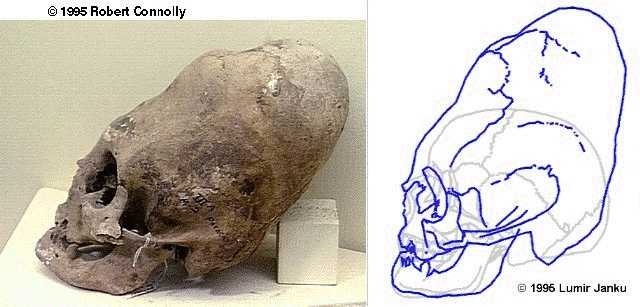
The "premodern" skull and the following three specimens were found in the Paracas region of Perú. It does not necessarily mean that they are related. There is some possibility that the "premodern" is in fact a precursor of the "conehead" type, but since we do not have any dating analysis at hand, we may only speculate in this regard.
The "conehead" type is very unusual because of the cranial shape. Here we have three specimens, which exclude the possibility of random or artificial deformation (the already mentioned Nubian deformations had quite a number of individual variations). They have individual characteristics within the range of overall morphology. There is no doubt that they are closely related and possibly represent quite a distinct branch of the genus Homo, if not an entirely different species.
The comparison of the C1 with a modern human skull has slight inaccuracies, caused by a degree of distortion when rotating the skull shape into position. As is obvious from C2 and C3, the angle of the bottom part of the cranium does not deviate from normal. However, the general proportions are correct.
The enormity of the cranial vault is obvious from all three pictures. By interpolation, we can estimate the minimum cranial capacity at 2200 ccm, but the value can be as high as 2500 ccm. The shape of the skull may be a biological response--a survival of the species mechanism--to increase the brain mass without the danger of relegating the species to extinction and keeping a viable biological reproduction intact. However, since we do not see the representatives of the "conehead" type in modern population, something prevented the type becoming as widespread as it is in the case of present-day moderns.
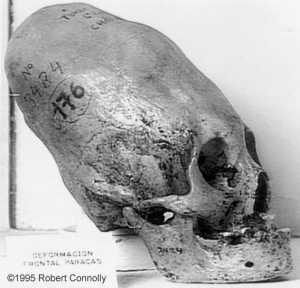
The "J" type of skull presents different sets of problems. It is an equivalent of the modern type of skull in all respects, with only several factors out of proportion. Less significant is the size of eye sockets which are about 15% larger than in modern populations. More significant is the enormity of the cranial vault. The estimated cranial capacity ranges between minimum of 2600 ccm to 3200 ccm.
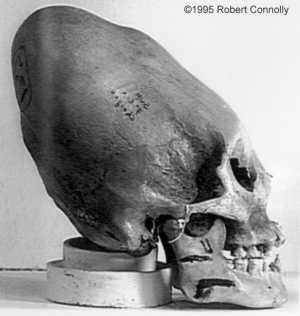
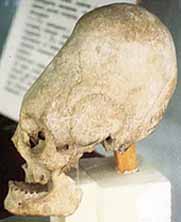
Pravda News - October 6, 2005
Russian media outlets have recently covered a story about yet another mystery of the ancient period of human civilization, when archaeologists discovered plates with drawings in South America. The plates or the so-called Iki stones are about 70 million years old. The drawings show people with disproportionately large heads. There are skulls of the same shape in the local museums. But archeologists find the elongated skulls in Russia too, in the North Caucasus. The Pyatigorsk museum of regional studies has them on display. Do those skulls have anything in common? And who started "the fashion?"
A hole in the crown of the head
"The Pyatigorsk skull was found at the excavation site of the Khasaot burial ground in the vicinity of Kislovodsk," says Doctor of Historical Sciences Vladimir Kuznetsov, the author of numerous studies of history of the North Caucasus. "The skull is part of culture of the ancient Alani. Approximately, it dates back to the 3rd - 5th centuries A.D. These strange skulls appeared at the same time when the Sarmatian and Alani hordes came around. Some of the nomads moved for the North Caucasus in 15th century."
"Researchers have repeatedly proved that the skulls had been deformed on purpose," says Mr. Kuznetsov. "Ropes or special blocks were tied tightly round the heads of infants, over the temples. The custom went out of fashion by 17th century. The reason behind the deformation phenomenon is still unknown. It is hard to say whether the methods worked effectively or not since nobody ever conducted scientific experiments regarding the binding of the infants' heads.
But "aliens" are not likely to be involved in this case," says the researcher.
Still, it is very strange that the deformed skulls are found in European countries including Norway and France. They are also found in Central Asia, in Central and South America. Taking into account huge distances and oceans separating different nations, how could people pass around the weird fashion?
"The skull exhibited here used to belong to a young woman in her twenties," says senior researcher of the Pyatigorsk museum of regional studies Mikhail Semendyaev. "Its volume is quite regular, about 1.5 liters. By the way, archeologists normally find 2-3 deformed skulls like this one in every hundred of skulls discovered during the excavation," adds Mr. Semendyaev.
Specialists have no explanation for a particular feature of the elongated skulls. If you take a closer look at the skull, you will see a tiny hole on the crown. The edges of the hole are extremely neat and even. Only elongated skulls have tidy holes. Could it be that the holes were used for picking information from space or from the egg-headed colleagues scattered around the world?
They wanted to look like aliens
"I did research on one of those skulls found near the town of Chihuahua in Mexico in the 1930s," says the well-known archeologist Lloyd Pye, the author of the book Everything You Know is Wrong. When the appearance of the "owner" was restored using Professor Gerasimov"s method, it became obvious that the guy resembled aliens the way they are portrayed by eyewitnesses. I ran a DNA test of his bones in two laboratories. His DNA links in some sections differed from the human ones. The skull should have contained around 2 liter of brain. The skull of present-day man can hold only 1.5 liters of brain," says Mr. Pye.
"Some specimens indicate that the "fashion" for elongated skulls is al least 20 thousand years old. It could have originated earlier on. I can not tell you exactly when. I can only assume that ancient people wanted to imitate somebody else. Maybe they wanted to look like those beings who were more perfect in terms of evolution. They could also imitate the aliens whose skulls probably had different dimensions," says Mr. Pye.




0 comments:
Post a Comment